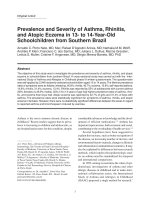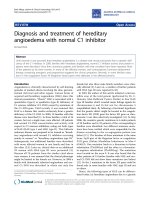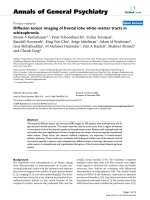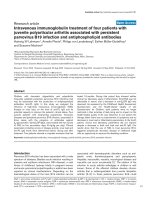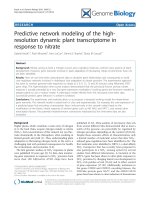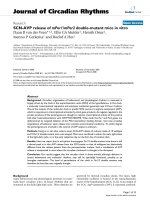Báo cáo y học: "Delayed endovascular treatment of descending aorta stent graft collapse in a patient treated for post- traumatic aortic rupture: a case report" ppsx
Bạn đang xem bản rút gọn của tài liệu. Xem và tải ngay bản đầy đủ của tài liệu tại đây (1.92 MB, 6 trang )
CAS E REP O R T Open Access
Delayed endovascular treatment of descending
aorta stent graft collapse in a patient treated for
post- traumatic aortic rupture: a case report
Giovanni Nano, Daniela Mazzaccaro
*
, Giovanni Malacrida, Maria Teresa Occhiuto, Silvia Stegher and
Domenico G Tealdi
Abstract
Background: We report a case of delayed endovascular correction of graft collapse occurred after emergent
Thoracic Endovascular Aortic Repair (TEVAR) for traumatic aortic isthmus rupture.
Case presentation: In 7
th
post-operative day after emergent TEVAR for traumatic aortic isthmus rupture (Gore
TAG
®
28-150), a partial collapse of the endoprosthesis at the descending tract occurred, with no signs of visceral
ischemia. Considering patient’s clinical conditions, the graft collapse wasn’t treated at that time. When general
conditions allowed reintervention, the patient refused any new treatment, so he was discharged.
Four months later the patient complainted for severe gluteal and sural claudication, erectile disfunction and
abdominal angina; endovascular correction was performed. At 18 months the graft was still patent.
Discussion and Conclusion: Graft collapse after TEVAR is a rare event, which should be detected and treated as
soon as possible. Delayed correction of this complication can be lethal due to the risk of visceral ischemia and
limbs loss.
Keywords: TEVAR traumatic aortic rupture, graft collapse
Introduction
Traumatic aortic isthmus rupture is the most common,
life-threatening, thoracic aorta emergency in males in
the fourth decade[1].
Endovascular technique is nowadays the gold standard
treatment for this kind of lesion[2], but this approach
may have s ome complications[3,4]. Graft collapse has
been described in 33 cases in literature[5-18]; according
to these r eports, a rei ntervention is needed to correct
this potentially lethal complication, either by open repair
or with endovascular approach, as soon as the collapse
is detected.
We report the case of an endovascular delayed repair
of acute graft collapse occurred in a 40 years-old man
who had been previously treated in emergency with
TEVAR for traumatic isthmus rupture following a moto-
cross accident.
Case presentation
A 40 years-old man was admitted to another hospital
after a motocross accident. He had lung and liver contu-
sion, right shoulder dislocation, multiple fractures of the
right ribs and pneumo-hemothorax, and his blood pres-
sure was 70/50 mmHg. A CT scan showed isthmus rup-
ture with dissection of the thoracic aorta (Figure. 1). He
was then transferred to our h ospital, where he was
immediately taken to operatory room to perform an
endovascular correction of the lesion: an endoprosthesis
(Gore TAG
®
28-150,W.L.GoreandAssociates,Flag-
staff, Ariz) was place d from the distal tract of the aortic
arch to the middle part of t he descending aorta, with
preservation of antegrade left subclavian artery flow.
Intraoperative angiogram s sho wed correct apposition of
the graft to the vessel wall, without any signs of endo-
leaks. The patient was then admitted to the Intensive
Care Unit for close monitoring and establishment of
respiratory and hemodynamic stability. He didn’t
* Correspondence:
University of Milan, Italy. 1
st
Unit of Vascular Surgery, IRCCS Policlinico San
Donato, 20097 San Donato Milanese (MI), Italy
Nano et al. Journal of Cardiothoracic Surgery 2011, 6:76
/>© 2011 Nano et al; licensee BioMed Central Ltd. This is an Open Access article d istributed under the terms of the Creative Commons
Attribution License ( which permits unrestricted use, distribution, and reproduction in
any medium, provided the origina l work is prop erly cited.
undergo any further surgical procedures for the treat-
ment of other non-vascular lesions.
Two days later a second CT scan was performed to con-
trol the correct placement of the graft, since the pat ient’s
hemodynamic condition was still unstable. The images
showed right lung emphysema, enlargement of medias ti-
num, pericardial effusion, bilateral pleural effusions wi th
pulmonary atelectasy due to compression of the parench-
yma and an increase of the haematoma surrounding the
aorti c arch and subclav ian artery; there weren’t any signs
of endoleak nor further bleeding (Figure. 2).
On the following week signs of aortic pseudocoarcta-
tion syndrome occurred, with no popliteal and tibial
pulses; femoral pulses were decreased b ut still palpable.
A new CT scan was then performed in 7
th
post-opera-
tive day: no signs of graft rupture were evident but
there was a partial collapse of the endoprosthesis at the
descending tract, with distal slow restoration of the
blood flow throughout the right lumen (Figure. 3); the
patient still had pulmonary atelectasis due to hemotorax
and ribs fractures.
Considering patient’s clinical conditions, the graft col-
lapse wasn’t treated at that time, waiting for hemodynamic
stability. Since then, the patient’s general conditions pro-
gressively improved enough to allow reintervention, but
the patient refused any new treatment, so he was
discharged.
Four months after the procedure the patient came
back to our Division. He complained for gluteal and
sural claudication with pain-free walking interval of less
than 40 meters and erectile disfunction; a chest and
abdominal radiography showed a subocclusion of the
graft. A ultrasound duplex examination of abdominal
aorta and lower limb arteries showed revascularization
flows throughout splancnic vessels and both common,
internal and external iliac arteries. We thus decided to
perform an angiography which demonstrated the
increased collapse of the aortic graft, confirming the
sub-occlusion of the central tract of its lumen, with a
delayed flow in the abdominal aorta (Figure. 4).
A second graft (Bolton Relay™ 28-155, Bolton Medical,
Barcelona, Spain) was then placed inside the previous one,
with a bare-stent which landed proximally to the left sub-
clavian artery (Figure. 5). As there were some difficulties
in ascending the guidewire across the collapsed graft, it
was ballon -dilated before introducing the new endograft.
Figure 1 Pre-operative CT scan. Preoperative CT-scan showing isthmus rupture with dissection of the thoracic aorta.
Nano et al. Journal of Cardiothoracic Surgery 2011, 6:76
/>Page 2 of 6
No post-dilatation was necessary. A single inner lumen
was restored to allow a continuous and valid blood flow to
the descending aorta. The patient was discharged four
days later in good clinical conditions. Peripheral pulses
were all presents and palpable.
At the 18th month follow-up a CT scan showed regu-
lar diameter of the graft, normal renal perfusion, no
signs of any endoleaks; the left subclavian artery
remained patent at follow-up (Figure. 6). The patient
returned to his previous daily activities; he didn’tcom-
plain of claudication anymore and its erectile function
had returned to normal.
Discussion and conclusion
There is no doubt that immediate diagnosis and treat-
ment are mandatory to reduce mortality of traumatic
thoracic aortic ruptures[19].
Since 1992 endovascular stent technology has been
proposed as a valid alternative to surgery in the treat-
ment of injured thoracic aorta[20]; endovascular repair
represents a less invasive therapy for the treatment of all
kinds of aortic diseases, including urgent management
of polytraumatic patients affected by aortic dissection.
Moreover, it carries encouraging early and medium-
term outcomes[19].
Anyw ay it carries several possible complications[3]; in
addition, endograft collapse was described mostly after
TEVAR for traumatic aortic rupture[5].
Review of the literature suggests that the timing of
collapse is highly variable and can occur fro m 3 days to
11 months[14]. It seemed to be significantly related with
smal l (<23 mm) aorti c diameters and second generation
TAG device[5]. Current grafts in fact are designed to
treat atherosclerotic diseases a nd they present greater
diameters. An excessive oversizing, greater than 25%
may cause wrinkling of t he graft with a lack of apposi-
tion to the aortic wall. Moreover young patients present
often acute angulated aortic necks with smaller radius of
the lesser curvature of the aortic arch; this may repre-
sent an inadequate proximal landing zone for current
grafts which have limited conformability and longitudi-
nal flexibility.
In our case, the proximal aortic diameter was 21 mm
and we used a 28 mm graft, with an oversizing of 33%.
Probably this high oversizing was one of the causes of
endograft collapse. Our main aim was however to save
the patient’ s life, as the patient needed an emergent
treatment; for logi stic reasons the oversized stent grafts
were the only type available in an emergency setting,
and we didn’t have the time to wait for the right graft.
Figure 2 CT scan at 2
nd
postoperative day. The images show good apposition of the graft to the aortic wall, with no signs of endoleak.
Nano et al. Journal of Cardiothoracic Surgery 2011, 6:76
/>Page 3 of 6
If we had had time we would have placed a smaller Bol-
ton Relay graft immediately.
Moreover, to minimize the risk of vertebro-basilar
insufficiency and paraplegia, we chose not to cover the
patient’ s left subclavian artery, even if it would have
ensured a better and longer proximal landing site.
Young patients, in fact, are at risk of left arm
claudication, even though it has been sh own that cover-
ing of the left subclavian artery can be performed with-
out significant morbidity[21].
Natural history of stent-graft collapse is not fully
understood; for this reason, all cases that are reported in
literature were treated as soon as they were detected. To
Figure 3 CT scan before discharge. Partial collapse of the endoprosthesis at the descending tract.
Figure 4 Angiogram during reintervention. The angiogram
demonstrates the increased collapse of the aortic graft with a sub-
occlusion of its lumen.
Figure 5 Correction of the lesion. A Bolton Relay™ 28-155 graft
located inside the previous one, with a bare-stent at the left
subclavian artery, restores a single inner lumen and allows a
continuous and valid blood flow to the descending aorta.
Nano et al. Journal of Cardiothoracic Surgery 2011, 6:76
/>Page 4 of 6
our knowledge, this report is the first case of delayed
repair of graft collapse; the delay was due to the comor-
bid conditions and the need to establish hemodynamic
stability. Moreover the patient didn’tshowanysignsof
visceral nor critical lower limb ischemia, so we opted
for a strict surveillance until general condition could
have improved and any new intervention could have
been performed.
Unfortunately, when general conditions had improv ed
enough to allow of a reintervention, the patient refused
any new treatment. We feared the occurrence of lethal
complications, such as visceral ischemia, and the impos-
sibility to perform the future correction through endo-
vascular approach: we aimed to avoid a thoracotomy in
a patient who was recovering from rib f ractures,
pneumo-hemothorax and lung contusion.
Four months later, symptoms had become disabling,
so the patient decided to undergo the reinte rvention;
correction of the lesion was then performed using an
additional endoprosthesis plus a bare stent deployed
inside the collapsed graft, slightly proximally, with good
clinical and technical results. We didn’ tuseasingle
stent or a single endograft because we wanted to ensure
a better proximal landing zone l eaving the left subcla-
vian artery still patent.
Discussion is still open about the best treatment of
this kind of complications, especially in young patients.
Nobody knows the po tential risk of aortoesophag eal fis-
tula[13].
In conclusion, TEVAR has significantly improved the
treatment of thoracic aortic rupture. Graft collapse is a
rare event, wh ich should be detecte d and treated as
Figure 6 CT scan at 18 months. Regular diameter of the graft, normal renal perfusion, no signs of any endoleaks.
Nano et al. Journal of Cardiothoracic Surgery 2011, 6:76
/>Page 5 of 6
soon as possible. Delayed correction of this complication
can be lethal due to the risk of visceral ischemia and
limbs loss.
Further technical modific ations of devices are neces-
sary in order to minimize complications and improve
clinical outcomes.
Consent
Written informed consent was obtained from the patient
for publication of this case report and accompanying
images. A copy of the written consent is available for
review by the Editor-in-Chief of this journal.
IRB Approval
Our institution approved the report of this case.
Authors’ contributions
GN designed the case report and performed the search in the literature.
DM participated in the design of the report and performed the search in the
literature.
GM, MTO, SS, DGT participated in the design and coordination of the report.
All authors read and approved the final manuscript.
Competing interests
The authors declare that they have no competing interests.
Received: 25 January 2011 Accepted: 24 May 2011
Published: 24 May 2011
References
1. Bertrand S, Cuny S, Petit P, Trosseille X, Page Y, Guillemot H, Drazetic P:
Traumatic rupture of thoracic aorta in real-world motor vehicle crashes.
Traffic Inj Prev .
2. Azizzadeh A, Keyhani K, Miller CC, Coogan SM, Safi HJ, Estrera AL: Blunt
traumatic aortic injury: initial experience with endovascular repair. J Vasc
Surg 2009, 49(6):1403-8.
3. Hansen CJ, Bui H, Donayre CE, Aziz I, Kim B, Kopchok G, Walot I, Lee J,
Lippmann M, White RA: Complications of endovascular repair of high-risk
and emergent descending thoracic aortic aneurysms and dissections. J
Vasc Surg 2004, 40:228-34.
4. Rodrigues Alves CM, da Fonseca JH, de Souza JA, Camargo Carvalho AC,
Buffolo E: Endovascular treatment of thoracic disease: patient selection
and a proposal of a risk score. Ann Thorac Surg 2002, 73:1143-8.
5. Canaud L, Alric P, Desgranges P, Marzelle J, Marty-Ané C, Becquemin JP:
Factors favoring stent-graft collapse after thoracic endovascular aortic
repair. J Thorac Cardiovasc Surg 2010, 139(5):1153-7.
6. Melissano G, Tshomba Y, Civilini E, Chiesa R: Disappointing results with a
new commercially available thoracic endograft. J Vasc Surg 2004,
39:124-30.
7. Idu MM, Reekers JA, Balm R, Ponsen KJ, de Mol BAJM, Legemate DA:
Collapse of a stent-graft following treatment of a traumatic thoracic
aortic rupture. J Endovasc Ther 2005, 12:503-7.
8. Mestres G, Maeso J, Fernandez V, Matas M: Symptomatic collapse of a
thoracic aorta endoprosthesis. J Vasc Surg 2006, 43:1270-3.
9. Hoornweg LL, Dinkelman MK, Goslings JC, Reekers JA, Verhagen HJ,
Verhoeven EL, Schurink GW, Balm R: Endovascular management of
traumatic ruptures of the thoracic aorta: a retrospective multicenter
analysis of 28 cases in the Netherlands. J Vasc Surg 2006, 43:1096-102.
10. Tehrani HY, Peterson BG, Katariya K, Morasch MD, Stevens R, DiLuozzo G,
Salerno T, Maurici G, Eton D, Eskandari MK: Endovascular repair of thoracic
aortic tears. Ann Thoracic Surg 2006, 82:873-8.
11. Steinbauer MG, Stehr A, Pfister K, Herold T, Zorger N, Töpel I, Paetzel C,
Kasprzak PM: Endovascular repair of proximal endograft collapse after
treatment for thoracic aortic disease. J Vasc Surg 2006, 43:609-12.
12. Hinchliffe RJ, Krasznai A, Schultzekool L, Blankensteijn JD, Falkenberg M,
Lönn L, Hausegger K, de Blas M, Egana JM, Sonesson B, Ivancev K:
Observations on the failure of stent-grafts in the aortic arch. Eur J Vasc
Endovasc Surg 2007, 34:451-6.
13. Go MR, Barbato JE, Dillavou ED, Gupta N, Rhee RY, Makaroun MS, Cho JS:
Thoracic endovascular aortic repair for traumatic aortic transection. J
Vasc Surg 2007, 46:928-33.
14. Rodd CD, Desigan S, Hamady MS, Gibbs RG, Jenkins MP: Salvage options
after stent collapse in the thoracic aorta. J Vasc Surg 2007, 46:780-5.
15. Muhs BE, Balm R, White GH, Verhagen HJ:
Anatomic factors associated
with acute endograft collapse after Gore TAG treatment of thoracic
aortic dissection or traumatic rupture. J Vasc Surg 2007, 45(4):655-61.
16. Neschis DG, Moaine S, Gutta R, Charles K, Scalea TM, Flinn WR, Griffith BP:
Twenty consecutive cases of endograft repair of traumatic aortic
disruption: Lessons learned. J Vasc Surg 2007, 45:487-92.
17. Canaud L, Alric P, Branchereau P, Marty-Ané C, Berthet JP: Lessons learned
from midterm follow-up of endovascular repair for traumatic rupture of
the aortic isthmus. J Vasc Surg 2008, 47:733-8.
18. Leung DA, Davis I, Katlaps G, Tisnado J, Sydnor MK, Komorowski DJ,
Brinster D: Treatment of infolding related to the Gore TAG thoracic
endoprosthesis. J Vasc Interv Radiol 2008, 19:600-5.
19. Bortone A, De Cillis E, D’Agostino D, de Luca Tupputi Schinosa L:
Endovascular treatment of thoracic aortic disease: four years of
experience. Circulation 2004, 14;110(11 Suppl 1):II262-7.
20. Semba CP, Kato N, Kee ST, Lee GK, Mitchell RS, Miller DC, Dake MD: Acute
rupture of the descending thoracic aorta: repair with use of
endovascular stent-grafts. J Vasc Interv Radiol 1997, 8(3):337-42.
21. Görich J, Asquan Y, Seifarth H, Krämer S, Kapfer X, Orend KH, Sunder-
Plassmann L, Pamler R: Initial experience with intentional stent-graft
coverage of the subclavian artery during endovascular thoracic aortic
repairs. J Endovasc Ther 2002, 9(suppl II):II-39-II-43.
doi:10.1186/1749-8090-6-76
Cite this article as: Nano et al.: Delayed endovascular treatment of
descending aorta stent graft collapse in a patient treated for post-
traumatic aortic rupture: a case report. Journal of Cardiothoracic Surgery
2011 6:76.
Submit your next manuscript to BioMed Central
and take full advantage of:
• Convenient online submission
• Thorough peer review
• No space constraints or color figure charges
• Immediate publication on acceptance
• Inclusion in PubMed, CAS, Scopus and Google Scholar
• Research which is freely available for redistribution
Submit your manuscript at
www.biomedcentral.com/submit
Nano et al. Journal of Cardiothoracic Surgery 2011, 6:76
/>Page 6 of 6

